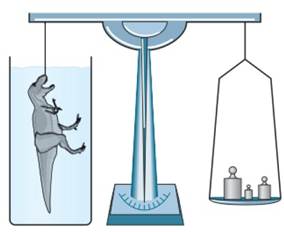
Concept explainers
When researchers find a reasonably complete fossil of a dinosaur, they can determine the mass and weight of the living dinosaur with a scale model sculpted from plastic and based on the dimensions of the fossil bones. The scale of the model is 1/20; that is, lengths are 1/20 actual length, areas are (l/20)2 actual areas, and volumes are (1/20)3 actual volumes. First, the model is suspended from one arm of a balance and weights are added to the other arm until equilibrium is reached. Then the model is fully submerged in water and enough weights are removed from the second arm to reestablish equilibrium (Fig 14-42). For a model of a particular T. rex fossil, 637.76 g had to be removed to reestablish equilibrium. What was the volume of (a) the model and (b) the actual T. rex (c)? If the density of T. rex was approximately the density of water, what was its mass?

Figure 14-42 Problem 43.
Want to see the full answer?
Check out a sample textbook solution
Chapter 14 Solutions
Fundamentals of Physics Extended
Additional Science Textbook Solutions
University Physics (14th Edition)
Essential University Physics: Volume 1 (3rd Edition)
University Physics Volume 2
Applied Physics (11th Edition)
Cosmic Perspective Fundamentals
Life in the Universe (4th Edition)
- A horizontal pipe 10.0 cm in diameter has a smooth reduction to a pipe 5.00 cm in diameter. If the pressure of the water in the larger pipe is 8.00 104 Pa and the pressure in the smaller pipe is 6.00 104 Pa, at what rate does water flow through the pipes?arrow_forwardThe gravitational force exerted on a solid object is 5.00 N. When the object is suspended from a spring scale and submerged in water, the scale reads 3.50 N (Fig. P15.24). Find the density of the object. Figure P15.24 Problems 24 and 25.arrow_forwardThe inside diameters of the larger portions of the horizontal pipe depicted in Figure P9.45 are 2.50 era. Water flows to the right at a rate of 1.80 104 m3/s. Determine the inside diameter of the constriction. Figure P9.45arrow_forward
- A fluid flows through a horizontal pipe that widens, making a 45 angle with the y axis (Fig. P15.48). The thin part of the pipe has radius R, and the fluids speed in the thin part of the pipe is v0. The origin of the coordinate system is at the point where the pipe begins to widen. The pipes cross section is circular. a. Find an expression for the speed v(x) of the fluid as a function of position for x 0 b. Plot your result: v(x) versus x. FIGURE P15.48 (a) The continuity equation (Eq. 15.21) relates the cross-sectional area to the speed of the fluid traveling through the pipe. A0v0 = A(x)v(x) v(x)=A0v0A(x) The cross sectional area is the area of a circle whose radius is y(x). The widening pan of the pipe is a straight line with slope of 1 and intercept y(0) = R. y(x) = mx + b = x + R A(x) = [y(x)]2 = (x + R)2 Plug this into the formula for the velocity. Plug this into the formula for the velocity. v(x)=A0v0(x+R)2arrow_forwardA 1.00-kg beaker containing 2.00 kg of oil (density = 916.0 kg/m3) rests on a scale. A 2.00-kg block of iron suspended from a spring scale is completely submerged in the oil as shown in Figure P15.63. Determine the equilibrium readings of both scales. Figure P15.63 Problems 63 and 64.arrow_forwardReview. In a water pistol, a piston drives water through a large tube of area A1 into a smaller tube of area A2 as shown in Figure P14.46. The radius of the large tube is 1.00 cm and that of the small tube is 1.00 mm. The smaller tube is 3.00 cm above the larger tube. (a) If the pistol is fired horizontally at a height of 1.50 m, determine the time interval required for the water to travel from the nozzle to the ground. Neglect air resistance and assume atmospheric pressure is 1.00 atm. (b) If the desired range of the stream is 8.00 m, with what speed v2 must the stream leave the nozzle? (c) At what speed v1 must the plunger be moved to achieve the desired range? (d) What is the pressure at the nozzle? (e) Find the pressure needed in the larger tube. (f) Calculate the force that must be exerted on the trigger to achieve the desired range. (The force that must be exerted is due to pressure over and above atmospheric pressure.) Figure P14.46arrow_forward
- The inside diameters of the larger portions of the horizontal pipe depicted in Figure P9.45 are 2.50 era. Water flows to the right at a rate of 1.80 104 m3/s. Determine the inside diameter of the constriction. Figure P9.45arrow_forwardHow many cubic meters of helium are required to lift a balloon with a 400-kg payload to a height of 8 000 m? Take He = 0.179 kg/m3. Assume the balloon maintains a constant volume and the density of air decreases with the altitude z according to the expression air = 0ez/8, where z is in meters and 0 = 1.20 kg/m3 is the density of air at sea level.arrow_forwardA garden hose with a diameter of 2.0 cm is used to fill a bucket, which has a volume of 0.10 cubic meters. It takes 1.2 minutes to fill. An adjustable nozzle is attached to the hose to decrease the diameter of the opening, which increases the speed of the water. The hose is held level to the ground at a height of 1.0 meters and the diameter is decreased until a flower bed 3.0 meters away is reached. (a) What is the volume flow rate of the through the nozzle when the diameter 2.0 cm? (b) What does is the speed of coming out of the hose? (c) What does the speed of the water coming out of the hose need to be to reach the flower bed 3.0 meters away? (d) What is be diameter of nozzle needed to reach be flower bed?arrow_forward
 University Physics Volume 1PhysicsISBN:9781938168277Author:William Moebs, Samuel J. Ling, Jeff SannyPublisher:OpenStax - Rice University
University Physics Volume 1PhysicsISBN:9781938168277Author:William Moebs, Samuel J. Ling, Jeff SannyPublisher:OpenStax - Rice University Principles of Physics: A Calculus-Based TextPhysicsISBN:9781133104261Author:Raymond A. Serway, John W. JewettPublisher:Cengage Learning
Principles of Physics: A Calculus-Based TextPhysicsISBN:9781133104261Author:Raymond A. Serway, John W. JewettPublisher:Cengage Learning College PhysicsPhysicsISBN:9781285737027Author:Raymond A. Serway, Chris VuillePublisher:Cengage Learning
College PhysicsPhysicsISBN:9781285737027Author:Raymond A. Serway, Chris VuillePublisher:Cengage Learning Physics for Scientists and Engineers, Technology ...PhysicsISBN:9781305116399Author:Raymond A. Serway, John W. JewettPublisher:Cengage Learning
Physics for Scientists and Engineers, Technology ...PhysicsISBN:9781305116399Author:Raymond A. Serway, John W. JewettPublisher:Cengage Learning Physics for Scientists and Engineers: Foundations...PhysicsISBN:9781133939146Author:Katz, Debora M.Publisher:Cengage Learning
Physics for Scientists and Engineers: Foundations...PhysicsISBN:9781133939146Author:Katz, Debora M.Publisher:Cengage Learning Physics for Scientists and Engineers with Modern ...PhysicsISBN:9781337553292Author:Raymond A. Serway, John W. JewettPublisher:Cengage Learning
Physics for Scientists and Engineers with Modern ...PhysicsISBN:9781337553292Author:Raymond A. Serway, John W. JewettPublisher:Cengage Learning





